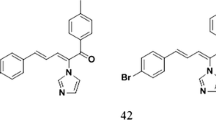Abstract
A turbidometric method was used to measure Candida albicans yeast cell growth and to quantitate the postantifungal effect (PAFE) after exposure to various concentrations of flucytosine and amphotericin B, alone and in combination, for 2 hr at 30°C. The drug concentrations used in the PAFE assays were determined by initial MIC and FIC (fractional inhibitory concentration) evaluations. The PAFE was calculated by the difference in time (hr) required for growth of the control and test cultures to reach the 0.5 absorbance level following removal of the drug by dilution. A synergistic PAFE was evidenced with combinations of the two drugs at concentrations below their individual MICs. Combinations of flucytosine (0.012 to 0.049 μg ml−1) and amphotericin B (0.195 to 0.39 μg ml−1) produced PAFEs ranging from 6.3 to 21.8 hr. These PAFEs persisted from 0.3 to 14.7 hr longer than those achieved when each of the two agents was assayed separately.
Similar content being viewed by others
References
Scalarone GM, Mikami Y, Kurita N, Yazawa K, Miyaji M. Postantifungal effect of 5-fluorocytosine on Candida albicans. J Antimicrob Chemother 1992; 29: 129–136.
Scalarone GM, Mikami Y, Kurita N, Ichihara Y, Yazawa K, Miyaji M. Turbidometric characterization of the postantifungal effect: Comparative studies with amphotericin B, 5-fluorocytosine and miconazole on Candida albicans. Mycoses 1992; 34: 297–302.
McDonald PJ, Craig WA, Kunin CM. Persistent effect of antibiotics on Staphylococcus aureus after exposure for limited periods of time. J Infect Dis 1977; 135: 217–227.
Bundtzen RW, Gerber AU, Cohn DL, Craig WA. Postantibiotic suppression of bacterial growth. Rev Infect Dis 1981; 3: 28–37.
Gerber AU, Craig WA. Growth kinetics of respiratory pathogens after short exposures to ampicillin and erythromycin in vitro. J Antimicrob Chemother 1981; 8: 81–91.
Vogelman BS, Craig WA. Postantibiotic effects. J Antimicrob Chemother 1985; 15: 37–46.
Polak A. Combination therapy for systemic mycosis. Infection 1989; 17: 203–209.
Sugar AM. Interactions of amphotericin B and SCH 39304 in the treatment of experimental murine candidiasis: Lack of antagonism of a polyene-azole combination. Antimicrob Agents Chemother 1991; 35: 1669–1671.
Hanson LH, Perlman AM, Clemons KV, Stevens DA. Synergy between cilofungin and amphotericin B in a murine model of candidiasis. Antimicrob Agents Chemother 1991; 35: 1334–1337.
Larsen RA, Leal MAE, Chan LS. Fluconazole compared with amphothericin B plus flucytosine for cryptococcal meningitis in AIDS. Ann Int Med 1990; 113: 183–187.
Allendoerfer R, Marquis AJ, Rinaldi MG, Graybill JR. Combined therapy with fluconazole and flucytosine in murine cryptococcal meningitis. Antimicrob Agents Chemother 1991; 35: 726–729.
Sugar AM, Goldani LZ, Picard M. Treatment of murine invasive candidiasis with amphotericin B and cilofungin: Evidence of enhanced activity with combination therapy. Antimicrob Agents Chemother 1991; 35: 2128–2130.
Wasan KM, Vadiei K, Luke DR, Keyhani A, White RA, McQueen TJ, Mehta R, Lopez-Berenstein G. Antifungal activity of HWA-138 and amphotericin B in experimental systemic candidiasis. Antimicrob Agents Chemother 1991; 35: 2046–2048.
Bodey GP. Topical and systemic antifungal agents. Med Clin N Amer 1988; 72: 637–659.
Stamm AM, Diasio RB, Dismukes WA, Shadomy S, Cloud GA, Bowles CA, Karam GH, Espinel-Ingroff A. Toxicity of amphotericin B plus flucytosine in 194 patients with cryptococcal meningitis. Amer J Med 1987; 83: 236–242.
Mikami Y, Yazawa K, Matsumae A. Evaluation of in vitro antifungal activities of amphotericin B, fluconazole, itraconazole and miconazole on seven different antifungal assay media. Chemotherapy (Tokyo); 39: 761–770.
Berenbaum MC. A method for testing for synergy with any number of agents. J Infect Dis 1978; 137: 122–130.
Odds FC. Interactions among amphotericin B, 5-fluorocytosine, ketoconazole and miconazole against pathogenic fungi in vitro. Antimicrob Agents Chemother 1982; 22: 763–770.
Mikami Y, Uno J, Yazawa K, Arai T. Turbidometric characterization of growth inhibition by aztreonam, a synthetic monobactam antibiotic. Chemotherapy (Tokyo); 37: 723–730.
Galgiani JN. Antifungal susceptibility tests. Antimicrob Agents Chemother 1987; 31: 1867–1870.
Author information
Authors and Affiliations
Rights and permissions
About this article
Cite this article
Scalarone, G.M., Mikami, Y., Kurita, N. et al. Comparative studies on the postantifungal effect produced by the synergistic interaction of flucytosine and amphotericin B on Candida albicans . Mycopathologia 120, 133–138 (1992). https://doi.org/10.1007/BF00436389
Received:
Accepted:
Issue Date:
DOI: https://doi.org/10.1007/BF00436389




